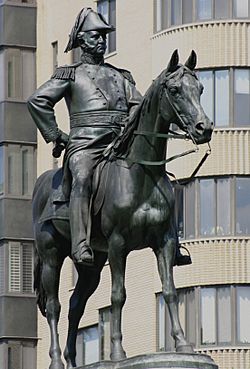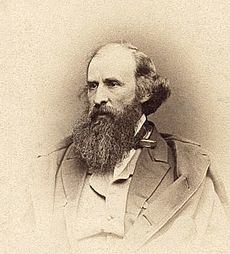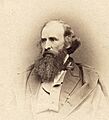Equestrian statue of Winfield Scott facts for kids
 |
|
| Coordinates | 38°54′26″N 77°02′11″W / 38.907239°N 77.0365089°W |
|---|---|
|
Equestrian statue of Winfield Scott
|
|
|
U.S. Historic district
Contributing property |
|
| Part of | Civil War Monuments in Washington, D.C. |
| NRHP reference No. | 78000257 |
| Added to NRHP | September 20, 1978 |
| Location | Scott Circle, Washington, D.C., United States |
| Designer | Henry Kirke Brown (sculptor) George Edward Harney or Orville E. Babcock (architect) Robert Wood & Company (founder) Jonas French (stonework) |
| Material | Bronze (sculpture) Granite (base) |
| Length | 10 feet (3.0 m) |
| Height | 15 feet (4.6 m) |
| Opening date | 1874 |
| Dedicated to | Winfield Scott |
The Brevet Lt. General Winfield Scott statue is a famous equestrian statue in Washington, D.C.. It honors a very important military leader named Winfield Scott. An equestrian statue shows a person riding a horse.
This monument stands in the middle of Scott Circle. This is a round traffic area and a small park. It's where 16th Street, Massachusetts Avenue, and Rhode Island Avenue meet. The statue was made by Henry Kirke Brown. He also created statues of George Washington and Nathanael Greene.
This statue was one of the first monuments built to honor Civil War generals in Washington, D.C. It was also the second statue in the city to honor General Scott. The statue and the park around it are cared for by the National Park Service. This is a part of the U.S. government.
Contents
Winfield Scott: A Military Hero
Winfield Scott (1786–1866) was a highly respected military officer. People called him "Old Fuss and Feathers" and the "Grand Old Man of the Army." He served as a general for a longer time than any other American officer.
Scott's Long Career
Scott's military career lasted for 53 years! He led soldiers in many important wars. These included the War of 1812, the Black Hawk War, and the Mexican–American War. He also served during the Seminette Wars and the Civil War.
He worked under every U.S. president from Thomas Jefferson to Abraham Lincoln. He was the Commanding General of the United States Army for 20 years. This was the longest time anyone held that job. After the Mexican–American War, he became very popular. He was even chosen to run for president in 1852.
Building the Scott Statue
After Winfield Scott passed away in 1866, many people wanted a monument to remember him. Veterans and other citizens asked the government to build a statue.
Getting Started on the Monument
In 1867, the U.S. Congress approved money for an equestrian statue. They approved more funds in 1870 and 1872. The artist chosen for the job was Henry Kirke Brown (1814–1886). He was a sculptor from New York. His statue of George Washington in New York City was very popular.
Brown also made other famous works in Washington, D.C. These include the Major General Nathanael Greene statue.
Designing the Statue
Brown finished a small model of the statue around 1872. The government gave him bronze cannons captured by Scott during the Mexican–American War. These cannons were melted down to make the statue.
Before the statue was cast, some of Scott's family members saw the model. They didn't like the design. Brown had made the horse a small mare, which Scott preferred to ride. But the family felt a general should ride a powerful stallion. They wanted a horse with flared nostrils and an arched neck. Brown made only small changes to his design.
The statue was cast by Robert Wood & Company. This company also made other statues in Washington, D.C.
The Statue's Base
The base of the statue is made of granite. It was carved from one huge block of stone. This block weighed more than 150 tons! At the time, it was the largest single stone ever taken from a quarry in the United States.
The architect who designed the base is not fully clear. Some historians say it was General Orville E. Babcock. Others say it was George Edward Harney. The stonework was done by Jonas French.
Where the Statue Stands
The statue was first planned for a different location, now called McPherson Square. But in 1874, the monument was placed at its current spot. The area, once known as Jamaica, was renamed Scott Circle in honor of General Scott. The total cost for the monument was about $77,000.
There was no big dedication ceremony for the statue. However, the park around it was beautifully landscaped with trees and flowers. This monument was the first of many Civil War memorials placed in Washington, D.C.'s traffic circles. General Scott is the only Civil War figure honored with two statues in the nation's capital. The other statue is at the Armed Forces Retirement Home.
Later Years of the Monument
The new monument helped the area around Scott Circle grow. Soon after it was built, important people like William Windom and Stilson Hutchins built large homes nearby. This area remained a popular place for wealthy people until the 1940s. Many of the mansions were then torn down.
In 1941, the statue was temporarily moved. This happened when a four-lane tunnel was built under the circle.
The Scott statue is one of eighteen Civil War monuments in Washington, D.C. All these monuments were added to the National Register of Historic Places in 1978. They were also listed on the District of Columbia Inventory of Historic Sites in 1979. The National Park Service owns and takes care of the monument and the park.
Statue Design and Location
The Scott monument is in the center of Scott Circle. This circle is where 16th Street, Massachusetts Avenue, and Rhode Island Avenue meet. It is near the Dupont Circle and Logan Circle neighborhoods.
Scott Circle is seen as the start of Embassy Row. The Australian Embassy looks over the circle and the statue. The statue faces south, looking down 16th Street towards the White House.
The park around the statue has two small, triangular areas. The Daniel Webster Memorial is on the west side. The Samuel Hahnemann Monument is on the east side. These are also listed on the National Register of Historic Places. The statue and the main circle area are not for walking. People use the smaller side areas to get around.
Statue Details
The bronze statue is 15 ft (4.6 m) tall and 10 ft (3.0 m) long. The granite base it sits on is 24 ft (7.3 m) wide and 30 ft (9.1 m) long. The name "SCOTT" is carved on the south side of the base.
The statue shows General Scott wearing his field uniform. This includes a hat, a long jacket with fringed epaulets, and a decorative sash. He is riding his horse and holding the reins in his left hand. His right hand holds a pair of field glasses and rests on his hip. His sword hangs on his left side. The base of the statue has many decorative carvings.
Images for kids
See also
 In Spanish: Estatua ecuestre de Winfield Scott para niños
In Spanish: Estatua ecuestre de Winfield Scott para niños




